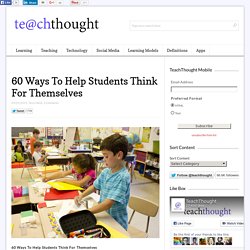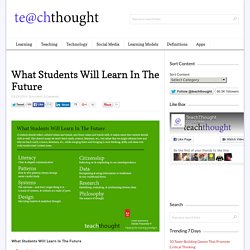

60 Ways To Help Students Think For Themselves. 60 Ways To Help Students Think For Themselves by Terry Heick Motivating and engaging students is the goal of most teachers–priming them to receive instruction, or otherwise align themselves to a pre-set process you’ve sketched out that you hope will yield a learning goal you selected beforehand.

But I’ve also been thinking recently of how learning actually happens–the causes of learning. Learning events, maybe. Eh. So I came up with 60 (of millions) of these “learning events” (for lack of a better term)–circumstances in which students seem to learn effortlessly. How does this happen–especially when you have a very specific daily learning target you’re trying to meet in pursuit of an academic standard? What Students Will Learn In The Future. What Students Will Learn In The Future by Terry Heick This is part 1 of the series “Responsive Teaching For A Changing World,” a 3-part series is sponsored by Adobe Presenter 9.

They had nothing to do with the content–only asked that we include a link back to their platform, which you can see above. A lot is implied in the content areas we choose to disperse the world through. That’s essentially what classes and content areas are–perspectives to make sense of the world. These words and phrases that we now associate with schools, teachers, and assignments reflect our priority as a culture. The Past While that content changes some as students move from Kindergarten to 12th grade, in general the kinds of things we ask our 2nd graders to study is similar to what we have our high school seniors study.
The “trivium” was designed to precede the Quadrivium (you guessed it–“the 4 ways”)–Arithmetic, Geometry, Music, & Astronomy. Content Should Reflect Cultural Values & Trends. The Ultimate STEM Guide for Kids: 239 Cool Sites. Discover Design: A student design experience. Camps. Projects Archive. Idea. Resources. Geniushour - home. Minecraft in Education. The Genius Hour Design Cycle: A Process For Planning - 3.

Some students need a push in the right direction Some students will come up with projects that are too simple with answers that could be easily Googled. We introduced the students to ‘High Order Thinking Skills’ and built these into the planning forms students complete. Projects need to include elements of synthesis, evaluation and creativity with the minimum requirement adjusted for individuals.
We provide students with a list of verbs appropriate for the top levels of Bloom’s taxonomy and help them use these in framing their topics. 4. A student might have a passion for surfing and decide they are going to write a book about the history of the sport. 5. It can be hard to say no to a project but some are just not feasible. 6. Some projects will clearly take longer than you have available, others are simply too large in scale or will rely on the involvement of too many people. 7.
One of the challenges for some students has been the ever changing project. 8. Step-by-Step Directions for Creating Passion Projects in Our Classroom. 20-Time In Education Inspire. Create. Innovate. Genius Hour Topic Selections. The Durango Herald 06/23/2015. With construction more than 50 percent complete, the dream of a new $7 million outdoor learning center in Monticello, Utah, is quickly becoming reality.

Enlarge photo Courtesy of MHTN Architects An exterior rendering of the Canyon Country Discovery Center in Monticello, Utah. Courtesy of Four Corners School of Outdoor Education Scott Shishim, a bioregional outdoor education project educator from Colorado, attends a conference in Utah where he will build educational curriculum centered around the Colorado Plateau to bring back to his students. Canyon Country Youth Corps summer youth crew participants make dinner at basecamp in Eastland, Utah, during their time off.
With thousands of children in the Four Corners to draw from, and an estimated 2 million tourists driving by every year on a world-renowned national park swing, a small group with a big idea is excited about the possibilities for this new building just north of Monticello’s town limits. The programs offered since 1984 will continue. Genius Hour. Steps to Help Low-Income Students Direct Their Own Learning. When Susan Wolfe, an elementary school teacher in Boise, Idaho, asks her class the qualities of a good student, kids often list things like: taking responsibility for themselves, doing homework, being good communicators. By focusing on the what the students believe — instead of what she could dictate to them — Wolfe applies techniques of student-centered learning, which she has embraced throughout her 18-year teaching career working almost exclusively in Title I schools.
“The kids need to believe that they’re not here to have learning crammed down their throats,” she said. She says it is fundamental for teachers to take the time to build a class culture for which students take ownership. And contrary to many stereotypes about disadvantaged kids, in her experience, every child, no matter their background, wants that learning autonomy. To build that type of environment, Wolfe first asks students to list the qualities they think make a good student. The student made a total switch.